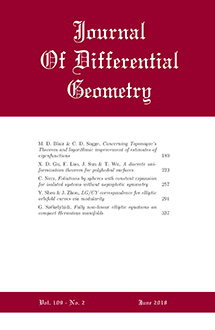Abstract
We prove a sharp area estimate for catenoids that allows us to rule out the phenomenon of multiplicity in min-max theory in several settings. We apply it to prove that i) the width of a three-manifold with positive Ricci curvature is realized by an orientable minimal surface ii) minimal genus Heegaard surfaces in such manifolds can be isotoped to be minimal and iii) the “doublings” of the Clifford torus by Kapouleas–Yang can be constructed variationally by an equivariant min-max procedure. In higher dimensions we also prove that the width of manifolds with positive Ricci curvature is achieved by an index $1$ orientable minimal hypersurface.
Funding Statement
D.K. was partially supported by NSF-PRF DMS-1401996 as well as by ERC-2011-StG-278940.
F.C.M. was partially supported by NSF-DMS 1509027.
A.N. was partially supported by ERC-2011-StG-278940 as well as an EPSRC Programme Grant EP/K00865X/1.
Citation
Daniel Ketover. Fernando C. Marques. André Neves. "The catenoid estimate and its geometric applications." J. Differential Geom. 115 (1) 1 - 26, May 2020. https://doi.org/10.4310/jdg/1586224840





